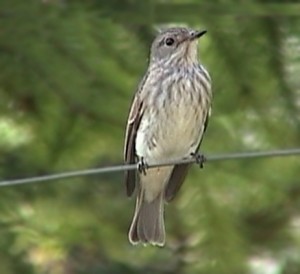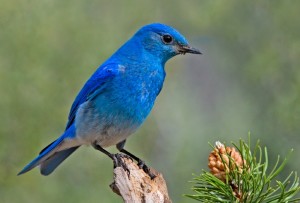At the weekend I went on a twitch, looking for a rare bird – except it is just a rarer bird rather than a really rare one.
I realised that I didn’t see a spotted flycatcher last year, partly because I was looking at mountain bluebirds instead, and I hadn’t seen one yet this year either.
, via Wikimedia Commons”] The spotted flycatcher is a bird in decline, all over Europe, and there are many places where I used to see them and now never do. And I miss them. They aren’t the most amazingly attractive of birds but they have an understated elegance and style which I wanted to enjoy again.
The spotted flycatcher is a bird in decline, all over Europe, and there are many places where I used to see them and now never do. And I miss them. They aren’t the most amazingly attractive of birds but they have an understated elegance and style which I wanted to enjoy again.
So on Saturday afternoon I headed off to see if I could find one. I went to Achurch churchyard, not because I have ever seen a spotted flycatcher there but because it is a quintessentially English country churchyard which looks made for spotted flycatchers in May.
As I approached the church, just as in the image here, I walked to the right and looked at a few of the gravestones scattered across the freshly cut grass. In the far corner of the churchyard there were fewer gravestones and the grass remained uncut as yet. Seven male orange tip butterflies flew among the cuckoo flowers presumably waiting to intercept any passing females. I watched them for a while but no female butterflies arrived. And so I started looking for orange, orange tip eggs on the cuckoo flowers but couldn’t find any at all.
I watched the orange tips fluttering over the very green grass for a while and realised that I have hardly seen a female orange tip all spring and I haven’t found a single orange egg yet. The cold and dreary spring can’t have been good for them.
However, today was a hot day with a clear sky. A chiffchaff sang from the adjacent woods and a swallow called as it flew over.
, via Wikimedia Commons”] A red kite circled overhead and it was already moulting its wing feathers – there was an obvious gap in each wing.
A red kite circled overhead and it was already moulting its wing feathers – there was an obvious gap in each wing.
I sat on the stone wall in the sun and imagined a spotted flycatcher sitting on one of the gravestones – it would look quite perfect – but there wasn’t one.
I thought I heard something like a spotted flycatcher call behind me but I really wasn’t sure. It’s not a very distinguished call after all – lots of birds make thin ‘seep’ noises under a variety of circumstances.
The sun was nice and the butterflies were nice and the kites were nice and the churchyard was nice and it was very English so I wasn’t complaining.
And then I saw one – I bet you knew I would didn’t you? It was perched upright, facing me, out in the open on a horizontal branch. It was in the direction where I thought I might have heard a spotted flycatcher – so maybe I did.
This spotted flycatcher didn’t put on an amazing display of flycatching dexterity for me but it did sit around for a while giving me a good view before changing perch a few times and then heading out of sight. I didn’t see it catch a fly or anything else. It was joined by another spotted flycatcher for a while, although not very closely joined, so it wasn’t clear to me
, via Wikimedia Commons”] whether they were a pair or just neighbours. The bird which joined the first spot fly did at least have a big insect in its beak when I saw it but I didn’t see it catch anything either.
whether they were a pair or just neighbours. The bird which joined the first spot fly did at least have a big insect in its beak when I saw it but I didn’t see it catch anything either.
I enjoyed my five minutes with the spotted flycatchers in an English churchyard on a hot May afternoon with the orange tips fluttering over the grass. It’s good to know that they are still around and I felt pleased that I had chosen this as a place to find them – pleased that I had selected this lovely spot and pleased to be proved right that this was spot fly country.
This grey bird, the John Major of England’s birds, should remain a part of our lives. I’m glad it was an important part of mine last weekend.
And finally, for the next 20 days you can find me writing a daily blog back on the RSPB website. I’ve been asked to write about sustainability and biodiversity in the run up to the international conference in Rio de Janeiro on 20-22 June. I’ll put the link in here when I have it. But there will also be a daily blog here. I have a feeling there will be more on Wuthering Moors and more on hen harriers – who knows, there may be more on buzzards too? But I’ll try for a bit of variety too – GM crops are back in the news, declining farmland birds across Europe and other aspects of the natural world too. I have some good books to review as well. Time to scribble, scribble, scribble.
[registration_form]
I did manage to see spotted flycatcher last year, but so far not this, they seem to be scarcer this year and a little late in arriving. I can remember as a schoolboy that a wood on our then local golfcourse, quite a small wood that had been severely wind damaged the winter before, with almost all the conifers in it tipped over, contained several pairs. It was probably only the first or second time I spent much of several days looking at one species, something I’ve never forgotten. Hopefully I will see at least one soon. Despite the fact that I see Kites pretty often I always have to look, its almost hypnotic.
Lovely blog Mark bringing to mind some great early summer days long ago.
Spotted flycatchers have nested in the same crook of a grapevine under our bedroom window for years. Until last year’s no show, and to date, this year as well. We thought it could have been because a wasp nest was built near it in 2010, which we didn’t disturb, but if there is some other reason – well maybe I don’t feel so bad now. It isn’t because of a lack of insects here.
Update: We now have two pairs nesting on the cottage. Mrs Cobb has banned noisy lawn-mowing until they have all fledged. I’m hoping for a second brood year again, which would be a win-win-win outcome.
A wonderful post, Mark. I also love Spotted Flycatchers, which we mainly see here in Extremadura on passage (quite a few this spring), although some stay to breed. I remember my father (who was a doctor) showing a colleague who did not know anything about birds, a Spotted Flycatcher that was nesting in the porch of the hospital in South Wales. His friend replied “That’s nice, but how do you know they catch spotted flies?!”
Martin – welcome and that’s a lovely story! Hope all is well in that lovely part of Extremadura.
Apparently Red Kites in moult at this time of the year are failed breeders. Nesting birds go through their moult later.
Nice English story – I have a pair of Spotted Flycatchers that nest in the lane next to the house. Their annual appearance gives me hope we can still turn things round in this over populatued country.
derek – thanks for the info on the kites – I didn’t know that.
That is a lovely piece of writing Mark. (E)vocative rather than (pro)vocative. Is there no end to your talents?
There’s one in the gardens here at my work, which I’ve not bothered myself to go and see; being happy knowing just that its there.
After a full day of rain yesterday, its warming up and the sun is looking like it might put in an appearance, I think I might just go on a Spot Fly search. Thank you.
Bimbling – no beginning to them? Thank you.
Interesting your comment about orange tip eggs. I make a point of looking for them every year as far as work and time permit but have not found any so far in my neck of the woods in Newcastle.
Spotted flycatchers, I think, are a particularly charming addition to the summer and without being unduly rude to former Prime Minister I think it’s a bit harsh calling them the John Major of the bird world!
I thought it was a bit harsh too, as spotted flycatchers are so aerobatically entertaining. But – Sir John Major’s father was a sometime trapeze artist …
In the rose standing next to my parents’ front door in West Stour, Dorset, spotted flycatchers nest and bring up their young every summer. My mum and dad wait in eager anticipation for their return each year – and have not been disappointed for a long while. I agree with Jonathan, I think to call them the John Major of English birds is a little unfair. Yes, they may not be as colourful as some, but they are still pretty birds and utterly captivating to watch as they busy themselves building or feeding. We have huge fun watching them teach their little ones to fly.
They have become part of our family and if they ever didn’t show one May we would really miss our ‘spotties’.
Sue – welcome! And thank you for a lovely comment.
Hi Mark —I did see that Martin took the precaution of saying your views were not necessarily the RSPB views.Do hope so much you have enough influence with them that we see the petition pushed by RSPB.
You must obviously be held in high esteem by them.
Dennis – it suits us both that my views don’t necessarily have to be the RSPB’s.
The satisfaction of picking your Spot Fly location and then seeing not one but two is, I guess, rather like plotting the winner and the runner up of the Queen Mother Champion Chase from a few months out.
I, too, hope to see my first of 2012 in my parent’s garden in Cambridgeshire this weekend, where they have nested near the front door for many years.
Allen – welcome! Good luck. Give us a call if you are passing close to us (which you probably will be unless you take a very odd route!)
Hi Mark,think we both respect the RSPB immensely but of course there are always going to be differing opinions.
Think also that you must have been a big loss to RSPB but it was a brilliant move for you and us,it gave you a new challenge and my guess is a new lease of life.
Your readers have definitely benefited and you have got a complete new readership that must give you pleasure to have them with you.
Total of one rung at the patch this year !!
Good blog as usual.
Why the Mountain bluebird picture?
Ooops – misread the first line!!
Alf – Welcome! And keep reading, every word !
!
Standing Up for Nature
The idea of standing up for nature by doing the same things as we have done over the past 100 years or more , will do little other than keep everyone’s conscious clear and think they have really achieved an answer to the problems of climate change and environmental suicide.
Technological fixes we see at present being implemented, without a real concern to the damage they cause to the planet, by their production and use, amazes me, when we all should know better.
WE are all hung up on a fix that can be implemented without any real downside effects on our lifestyles. Most accept there is no gain without pain , but that is exactly what we are doing, and with no pain the planet is only getting into a worse state.
The pain should be borne by us all equally based on the damage we all actually do by using the money we all earn and spend. Fundamentally Money= potential energy, and when it is spent it releases that energy into the making of more goods and services, with the resulting release of CO2 and damage to eco and bio systems upon the planet.
It is only the direct linkage between money supply , value and natural resources, That will make the fast and dramatic changes that are required to reverse the climatic and environmental problems affecting the planet.
This can be solved , but with pain , and pain by the rich far more than the poor, as it is the rich that are causing the main problems.e with a single Natural Resource Tax based on the damage their use does directly on the planet.
This has the advantages that the individual has the responsibility of the direct damage they cause the environment through their spending habits.
The more we spend the more damage we do to the planet, but if the rich want to have fast cars , then they will have to pay exorbitantly for the privilege of killing the planet and the cost of cleaning it up again.
I believe only fundamental tax reform will effect the necessary change quickly enough , and as it only seems to be getting worse rather than better , we have not much time left..
Note
At this time of wars around the world , governments spend a lot less on environmental issue , By implementing this new tax system the planet remains first all the time , and we are sure to get to the final goal of environmental harmony so much quicker.